Surface radiation field tools
In this tutorial we demonstrate usage of several tools for checking the implementation of a surface radiation field extension module.
The required atmosphere data files are needed and they can be found in the Zenodo.
[1]:
%matplotlib inline
import warnings
warnings.filterwarnings(action='ignore')
import numpy as np
import os
[2]:
import xpsi
/=============================================\
| X-PSI: X-ray Pulse Simulation and Inference |
|---------------------------------------------|
| Version: 3.0.0 |
|---------------------------------------------|
| https://xpsi-group.github.io/xpsi |
\=============================================/
Imported emcee version: 3.1.6
Imported PyMultiNest.
Imported UltraNest.
Imported GetDist version: 1.5.3
Imported nestcheck version: 0.2.1
[3]:
from matplotlib import pyplot as plt
plt.rc('font', size=20.0)
Calculate the specific intensity directly from local variables
[4]:
# keV (local comoving frame)
E = np.logspace(-2.0, 0.5, 1000, base=10.0)
# cos(angle to local surface normal in comoving frame)
mu = np.ones(1000) * 0.5
# log10(eff. temperature [K]) and log10(local eff. gravity [cm/s^2])
local_vars = np.array([[6.11, 13.8]]*1000)
[5]:
#xpsi.surface_radiation_field?
[6]:
#xpsi.surface_radiation_field.intensity?
Isotropic blackbody
[7]:
plt.figure(figsize=(8,8))
BB_I = xpsi.surface_radiation_field.intensity(E, mu, local_vars, atmos_extension="BB", # NB: isotropic blackbody
region_extension='elsewhere', numTHREADS=2)
plt.plot(E, BB_I, 'k-', lw=2.0)
ax = plt.gca()
ax.set_yscale('log')
ax.set_xscale('log')
ax.set_ylabel('Photon specific intensity')
_ = ax.set_xlabel('Energy [keV]')
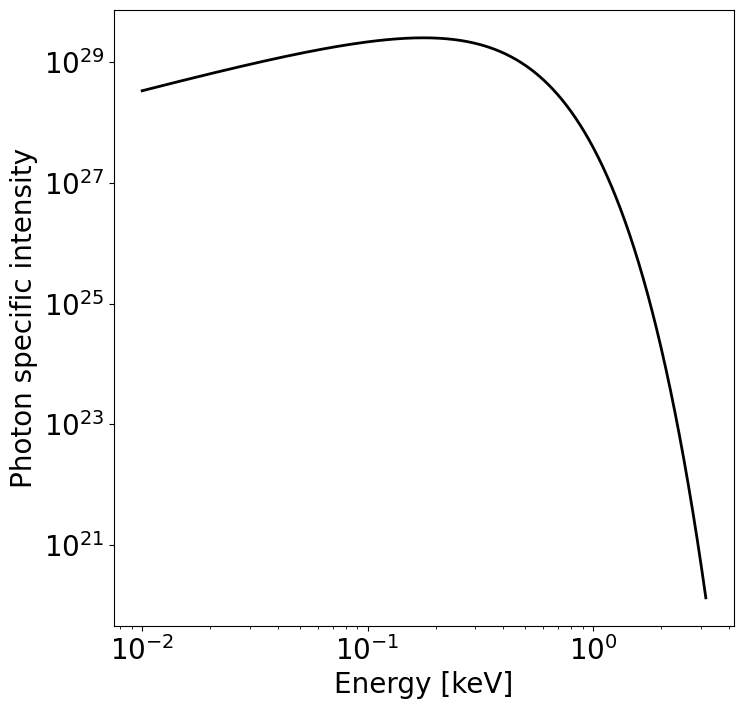
Polarized non-isotropic burst blackbody
[8]:
#Note: This block only works for X-PSI versions above 2.2.0.
plt.figure(figsize=(8,8))
BB_Q = xpsi.surface_radiation_field.intensity(E, mu, local_vars, atmos_extension="Pol_BB_Burst", stokesQ=1,
region_extension='hot', numTHREADS=2)
plt.plot(E, BB_Q, 'k-', lw=2.0)
ax = plt.gca()
ax.set_xscale('log')
ax.set_ylabel('Stokes Q intensity')
_ = ax.set_xlabel('Energy [keV]')
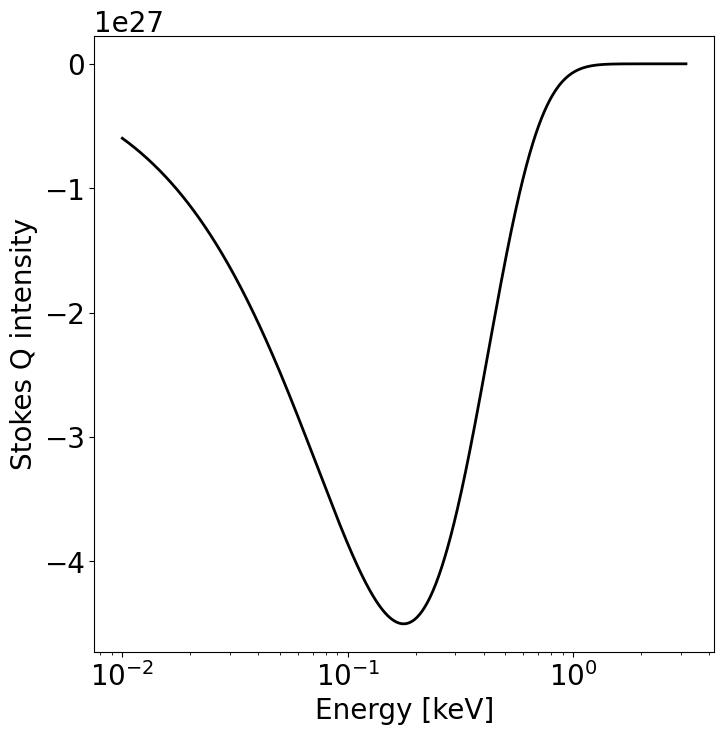
Numerical atmosphere
Let’s check out a numerical atmosphere (this code you typically find in a custom photosphere class). The numerical atmospheres loaded here were generated by the NSX atmosphere code (Ho & Lai (2001); Ho & Heinke (2009)), courtesy of W.C.G. Ho for NICER modeling efforts. One of these atmospheres (fully-ionized hydrogen; Ho & Lai 2001) was
used in Riley et al. (2019); also see Bogdanov et al. (2021) and Riley et al. (2021). For this tutorial we need the data files nsx_H_v171019.out and nsx_He_v170925.out that can be found in Zenodo. The repository includes also a fully-ionized
hydrogen data file with an extended surface gravity grid (nsx_H_v200804.out), which was used in Riley et al. (2021), but not in this tutorial.
[9]:
def preload(path, size):
NSX = np.loadtxt(path, dtype=np.double)
logT = np.zeros(size[0])
logg = np.zeros(size[1])
_mu = np.zeros(size[2]) # use underscore to bypass errors with the other mu array
logE = np.zeros(size[3])
reorder_buf = np.zeros(size)
index = 0
for i in range(reorder_buf.shape[0]):
for j in range(reorder_buf.shape[1]):
for k in range(reorder_buf.shape[3]):
for l in range(reorder_buf.shape[2]):
logT[i] = NSX[index,3]
logg[j] = NSX[index,4]
logE[k] = NSX[index,0]
_mu[reorder_buf.shape[2] - l - 1] = NSX[index,1]
reorder_buf[i,j,reorder_buf.shape[2] - l - 1,k] = 10.0**(NSX[index,2])
index += 1
buf = np.zeros(np.prod(reorder_buf.shape))
bufdex = 0
for i in range(reorder_buf.shape[0]):
for j in range(reorder_buf.shape[1]):
for k in range(reorder_buf.shape[2]):
for l in range(reorder_buf.shape[3]):
buf[bufdex] = reorder_buf[i,j,k,l]; bufdex += 1
atmosphere = (logT, logg, _mu, logE, buf)
return atmosphere
[10]:
H_fully = preload('../../examples/examples_modeling_tutorial/model_data/nsx_H_v171019.out',
size=(35, 11, 67, 166))
[11]:
He_fully = preload('../../examples/examples_modeling_tutorial/model_data/nsx_He_v170925.out',
size=(29, 11, 67, 166))
[12]:
plt.figure(figsize=(8,8))
plt.plot(E, BB_I, 'k--', lw=1.0)
hot_I = xpsi.surface_radiation_field.intensity(E, mu, local_vars,
atmosphere=H_fully,
region_extension='hot',
atmos_extension="Num4D",
numTHREADS=2)
plt.plot(E, hot_I, 'b-', lw=2.0)
elsewhere_I = xpsi.surface_radiation_field.intensity(E, mu, local_vars,
atmosphere=H_fully,
region_extension='elsewhere',
atmos_extension="Num4D",
numTHREADS=2)
plt.plot(E, elsewhere_I, 'r-', lw=1.0)
He_fully_I = xpsi.surface_radiation_field.intensity(E, mu, local_vars,
atmosphere=He_fully,
region_extension='hot',
atmos_extension="Num4D",
numTHREADS=2)
plt.plot(E, He_fully_I, 'k-.', lw=1.0)
ax = plt.gca()
ax.set_yscale('log')
ax.set_ylim([9.0e25,4.0e29])
ax.set_xscale('log')
ax.set_ylabel('Photon specific intensity')
_ = ax.set_xlabel('Energy [keV]')
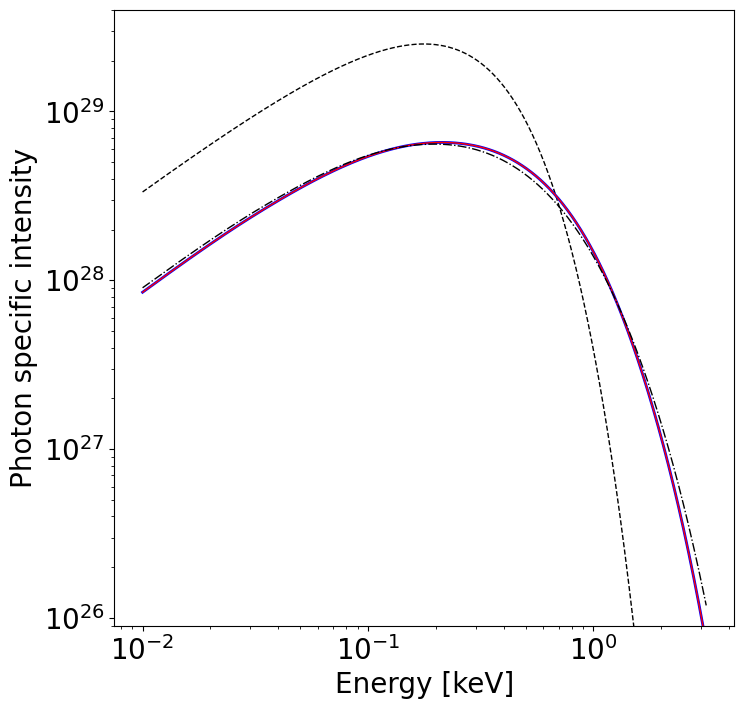
This behaviour is typical for an isotropic blackbody radiation field with temperature \(T\) in comparison to a radiation field emergent from a (non-magnetic, fully-ionized) geometrically-thin H/He atmosphere with effective temperature \(T\).
Let’s plot the angular dependence:
[13]:
# keV (local comoving frame)
E = np.ones(1000) * 0.2
# cos(angle to local surface normal in comoving frame)
mu = np.linspace(0.01,1.0,1000)
fig = plt.figure(figsize=(16,8))
# Hydrogen
ax = fig.add_subplot(121, projection='polar')
ax.set_theta_direction(1)
ax.set_thetamin(-90.0)
ax.set_thetamax(90.0)
# log10(eff. temperature [K]) and log10(local eff. gravity [cm/s^2])
local_vars = np.array([[6.0, 13.8]]*1000)
H_fully_I = xpsi.surface_radiation_field.intensity(E, mu, local_vars,
atmosphere=H_fully,
region_extension='hot',
atmos_extension="Num4D",
numTHREADS=2)
ax.plot(np.arccos(mu), np.log10(H_fully_I/np.max(H_fully_I)), 'k-', lw=1.0)
ax.plot(-np.arccos(mu), np.log10(H_fully_I/np.max(H_fully_I)), 'k-', lw=1.0)
# log10(eff. temperature [K]) and log10(local eff. gravity [cm/s^2])
local_vars = np.array([[5.5, 13.8]]*1000)
H_fully_I = xpsi.surface_radiation_field.intensity(E, mu, local_vars,
atmosphere=H_fully,
region_extension='hot',
atmos_extension="Num4D",
numTHREADS=2)
ax.plot(np.arccos(mu), np.log10(H_fully_I/np.max(H_fully_I)), 'r-', lw=1.0)
ax.plot(-np.arccos(mu), np.log10(H_fully_I/np.max(H_fully_I)), 'r-', lw=1.0)
# log10(eff. temperature [K]) and log10(local eff. gravity [cm/s^2])
local_vars = np.array([[6.5, 13.8]]*1000)
H_fully_I = xpsi.surface_radiation_field.intensity(E, mu, local_vars,
atmosphere=H_fully,
region_extension='hot',
atmos_extension="Num4D",
numTHREADS=2)
ax.plot(np.arccos(mu), np.log10(H_fully_I/np.max(H_fully_I)), 'b-', lw=1.0)
ax.plot(-np.arccos(mu), np.log10(H_fully_I/np.max(H_fully_I)), 'b-', lw=1.0)
ax.set_rmax(0.05)
ax.set_rmin(-1)
ax.set_theta_zero_location("N")
ax.set_rticks([-1.0,-0.5, 0.0])
ax.set_xlabel('log10$(I_E/I_E(\mu=1))$')
ax.xaxis.set_label_coords(0.5, 0.15)
_ = ax.set_title('H (fully-ionized)', pad=-50)
# Helium
ax = fig.add_subplot(122, projection='polar')
ax.set_theta_direction(1)
ax.set_thetamin(-90.0)
ax.set_thetamax(90.0)
# log10(eff. temperature [K]) and log10(local eff. gravity [cm/s^2])
local_vars = np.array([[6.0, 13.8]]*1000)
He_fully_I = xpsi.surface_radiation_field.intensity(E, mu, local_vars,
atmosphere=He_fully,
region_extension='hot',
atmos_extension="Num4D",
numTHREADS=2)
ax.plot(np.arccos(mu), np.log10(He_fully_I/np.max(He_fully_I)), 'k-', lw=1.0)
ax.plot(-np.arccos(mu), np.log10(He_fully_I/np.max(He_fully_I)), 'k-', lw=1.0)
# log10(eff. temperature [K]) and log10(local eff. gravity [cm/s^2])
local_vars = np.array([[5.5, 13.8]]*1000)
He_fully_I = xpsi.surface_radiation_field.intensity(E, mu, local_vars,
atmosphere=He_fully,
region_extension='hot',
atmos_extension="Num4D",
numTHREADS=2)
ax.plot(np.arccos(mu), np.log10(He_fully_I/np.max(He_fully_I)), 'r-', lw=1.0)
ax.plot(-np.arccos(mu), np.log10(He_fully_I/np.max(He_fully_I)), 'r-', lw=1.0)
# log10(eff. temperature [K]) and log10(local eff. gravity [cm/s^2])
local_vars = np.array([[6.5, 13.8]]*1000)
He_fully_I = xpsi.surface_radiation_field.intensity(E, mu, local_vars,
atmosphere=He_fully,
region_extension='hot',
atmos_extension="Num4D",
numTHREADS=2)
ax.plot(np.arccos(mu), np.log10(He_fully_I/np.max(He_fully_I)), 'b-', lw=1.0)
ax.plot(-np.arccos(mu), np.log10(He_fully_I/np.max(He_fully_I)), 'b-', lw=1.0)
ax.set_rmax(0.05)
ax.set_rmin(-1)
ax.set_theta_zero_location("N")
ax.set_rticks([-1.0,-0.5, 0.0])
ax.set_xlabel('log10$(I_E/I_E(\mu=1))$')
ax.xaxis.set_label_coords(0.5, 0.15)
_ = ax.set_title('He (fully-ionized)', pad=-50)
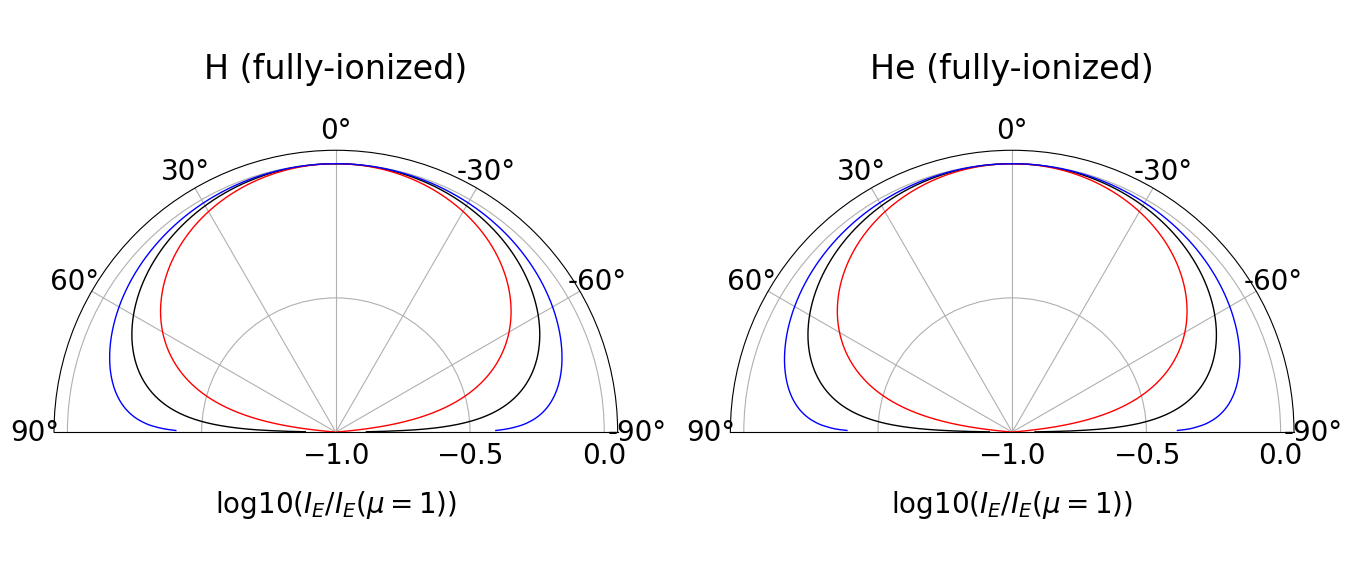
Calculate the specific intensity indirectly via global variables
We can also calculate intensities by specifying spacetime coordinates at the surface and values for some set of global variables that control the radiation field.
[14]:
#xpsi.surface_radiation_field.intensity_from_globals?
[15]:
# unimportant here; just use strict bounds
bounds = dict(mass = (None, None),
radius = (None, None),
distance = (None, None),
cos_inclination = (None, None))
spacetime = xpsi.Spacetime(bounds, dict(frequency = 1.0/(4.87e-3))) # J0030 spin
Creating parameter:
> Named "frequency" with fixed value 2.053e+02.
> Spin frequency [Hz].
Creating parameter:
> Named "mass" with bounds [1.000e-03, 3.000e+00].
> Gravitational mass [solar masses].
Creating parameter:
> Named "radius" with bounds [1.000e+00, 2.000e+01].
> Coordinate equatorial radius [km].
Creating parameter:
> Named "distance" with bounds [1.000e-02, 3.000e+01].
> Earth distance [kpc].
Creating parameter:
> Named "cos_inclination" with bounds [-1.000e+00, 1.000e+00].
> Cosine of Earth inclination to rotation axis.
[16]:
# keV (local comoving frame)
E = np.logspace(-2.0, 0.5, 1000, base=10.0)
# cos(angle to local surface normal in comoving frame)
mu = np.ones(1000) * 0.5
[17]:
colatitude = np.ones(1000) * 1.0 # radians
azimuth = np.zeros(1000)
phase = np.zeros(1000)
#The general format of the default global variables:
#np.array([self['p__super_colatitude'],
#self['p__phase_shift'] * 2.0 * math.pi,
#self['p__super_radius'],
#self['p__cede_colatitude'],
#self['p__phase_shift'] * 2.0 * math.pi - self['p__cede_azimuth'],
#self['p__cede_radius'],
#self['s__super_colatitude'],
#(self['s__phase_shift'] + 0.5) * 2.0 * math.pi,
#self['s__super_radius'],
#self['s__cede_colatitude'],
#(self['s__phase_shift'] + 0.5) * 2.0 * math.pi - self['s__cede_azimuth'],
#self['s__cede_radius'],
#self['p__super_temperature'],
#self['p__cede_temperature'],
#self['s__super_temperature'],
#self['s__cede_temperature']])
#For a star with uniform temperature:
global_vars = np.array([0.0,
0.0,
np.pi,
0.0,
0.0,
0.0,
0.0,
0.0,
0.0,
0.0,
0.0,
0.0,
6.11,
0.0,
0.0,
0.0])
[18]:
spacetime.params
[18]:
[Spin frequency [Hz] = 2.053e+02,
Gravitational mass [solar masses],
Coordinate equatorial radius [km],
Earth distance [kpc],
Cosine of Earth inclination to rotation axis]
[19]:
spacetime['radius'] = 12.0
spacetime['mass'] = 1.4
# we do not need the observer coordinates (typically handled
# by xpsi.Spacetime instances) to compute effective gravity so
# no need to set values
# the first 5 arguments are 1D arrays that specific a point sequence in the
# joint space of surface spacetime coordinates, energy, and angle
# if you have a set of such points that does not conform readily
# to a 1D array, write a custom wrapper to handle the structure
# in your point set
I_E = xpsi.surface_radiation_field.intensity_from_globals(E,
mu,
colatitude,
azimuth,
phase,
global_vars, # -> eff. temp.
spacetime.R, # -> eff. grav.
spacetime.zeta, # -> eff. grav.
spacetime.epsilon, # -> eff. grav.
atmosphere=H_fully,
atmos_extension="Num4D",
numTHREADS=2)
Note that only the hot region extension is invoked here.
Let’s plot the spectrum and also the spectrum generated by declaring the effective gravity directly above:
[20]:
plt.figure(figsize=(8,8))
plt.plot(E, hot_I, 'k-', lw=1.0)
plt.plot(E, I_E, 'r-', lw=1.0)
ax = plt.gca()
ax.set_yscale('log')
ax.set_xscale('log')
ax.set_ylabel('Photon specific intensity')
_ = ax.set_xlabel('Energy [keV]')
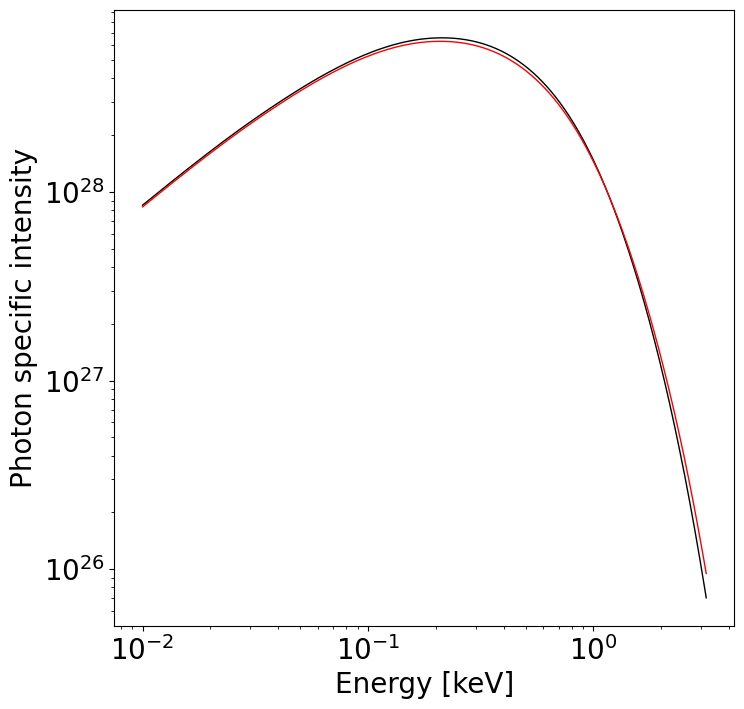
Comparing the pulse profiles from blackbody emission and numerical atmospheres
First some plotting methods for figures
Defining the spacetime
[21]:
bounds = dict(distance = (None, None), # Default bounds for (Earth) distance
mass = (1.0, 3.0), # Default bounds for mass
radius = (None, None), # Default bounds for equatorial radius
cos_inclination = (None, None)) # Default bounds for (Earth) inclination to rotation axis
values = dict(frequency=300.0 ) # Fixed spin frequency
spacetime = xpsi.Spacetime(bounds=bounds, values=values)
Creating parameter:
> Named "frequency" with fixed value 3.000e+02.
> Spin frequency [Hz].
Creating parameter:
> Named "mass" with bounds [1.000e+00, 3.000e+00].
> Gravitational mass [solar masses].
Creating parameter:
> Named "radius" with bounds [1.000e+00, 2.000e+01].
> Coordinate equatorial radius [km].
Creating parameter:
> Named "distance" with bounds [1.000e-02, 3.000e+01].
> Earth distance [kpc].
Creating parameter:
> Named "cos_inclination" with bounds [-1.000e+00, 1.000e+00].
> Cosine of Earth inclination to rotation axis.
Constructing the hot regions with blackbody emission
[22]:
bounds_hotregion = dict(super_colatitude = (None, None),
super_radius = (None, None),
phase_shift = (0.0, 0.1),
super_temperature = (None, None))
# a simple circular, simply-connected spot
primary_BB = xpsi.HotRegion(bounds=bounds_hotregion,
values={}, # no initial values and no derived/fixed
symmetry=True,
omit=False,
cede=False,
concentric=False,
sqrt_num_cells=32,
min_sqrt_num_cells=10,
max_sqrt_num_cells=64,
num_leaves=100,
num_rays=200,
do_fast=False,
atm_ext="BB",#default blackbody, other options: "Num4D" or "user"
prefix='p') # unique prefix needed because >1 instance
# overlap of an omission region and
# and a radiating super region
secondary_BB = xpsi.HotRegion(bounds=bounds_hotregion,
values={}, # no fixed/derived variables
symmetry=True,
omit=False,
cede=False,
concentric=False,
sqrt_num_cells=32,
min_sqrt_num_cells=10,
max_sqrt_num_cells=100,
num_leaves=100,
num_rays=200,
do_fast=False,
is_antiphased=True,
atm_ext="BB",#default blackbody, other options: "Num4D" or "user"
prefix='s')
from xpsi import HotRegions
hot_BB = HotRegions((primary_BB, secondary_BB))
Creating parameter:
> Named "super_colatitude" with bounds [0.000e+00, 3.142e+00].
> The colatitude of the centre of the superseding region [radians].
Creating parameter:
> Named "super_radius" with bounds [0.000e+00, 1.571e+00].
> The angular radius of the (circular) superseding region [radians].
Creating parameter:
> Named "phase_shift" with bounds [0.000e+00, 1.000e-01].
> The phase of the hot region, a periodic parameter [cycles].
Creating parameter:
> Named "super_temperature" with bounds [3.000e+00, 7.600e+00].
> log10(superseding region effective temperature [K]).
Creating parameter:
> Named "super_colatitude" with bounds [0.000e+00, 3.142e+00].
> The colatitude of the centre of the superseding region [radians].
Creating parameter:
> Named "super_radius" with bounds [0.000e+00, 1.571e+00].
> The angular radius of the (circular) superseding region [radians].
Creating parameter:
> Named "phase_shift" with bounds [0.000e+00, 1.000e-01].
> The phase of the hot region, a periodic parameter [cycles].
Creating parameter:
> Named "super_temperature" with bounds [3.000e+00, 7.600e+00].
> log10(superseding region effective temperature [K]).
Constructing the photosphere for the hot regions with blackbody emission
[23]:
class CustomPhotosphere_BB(xpsi.Photosphere):
""" Implement method for imaging."""
@property
def global_variables(self):
return np.array([self['p__super_colatitude'],
self['p__phase_shift'] * 2.0 * math.pi,
self['p__super_radius'],
0.0, #self['p__cede_colatitude'],
0.0, #self['p__phase_shift'] * 2.0 * math.pi - self['p__cede_azimuth'],
0.0, #self['p__cede_radius'],
self['s__super_colatitude'],
(self['s__phase_shift'] + 0.5) * 2.0 * math.pi,
self['s__super_radius'],
0.0, #self['s__cede_colatitude'],
0.0, #(self['s__phase_shift'] + 0.5) * 2.0 * math.pi - self['s__cede_azimuth'],
0.0, #self['s__cede_radius'],
self['p__super_temperature'],
0.0, #self['p__cede_temperature'],
self['s__super_temperature'],
0.0]) #self['s__cede_temperature']])
photosphere_BB = CustomPhotosphere_BB(hot = hot_BB, elsewhere = None,
values=dict(mode_frequency = spacetime['frequency']))
photosphere_BB
Creating parameter:
> Named "mode_frequency" with fixed value 3.000e+02.
> Coordinate frequency of the mode of radiative asymmetry in the
photosphere that is assumed to generate the pulsed signal [Hz].
[23]:
Free parameters
---------------
p__phase_shift: The phase of the hot region, a periodic parameter [cycles].
p__super_colatitude: The colatitude of the centre of the superseding region [radians].
p__super_radius: The angular radius of the (circular) superseding region [radians].
p__super_temperature: log10(superseding region effective temperature [K]).
s__phase_shift: The phase of the hot region, a periodic parameter [cycles].
s__super_colatitude: The colatitude of the centre of the superseding region [radians].
s__super_radius: The angular radius of the (circular) superseding region [radians].
s__super_temperature: log10(superseding region effective temperature [K]).
Derived/fixed parameters
------------------------
mode_frequency: Coordinate frequency of the mode of radiative asymmetry in the
photosphere that is assumed to generate the pulsed signal [Hz].
Constructing the star with the blackbody photosphere
[24]:
star_BB = xpsi.Star(spacetime = spacetime, photospheres = photosphere_BB)
star_BB.params
[24]:
[Gravitational mass [solar masses],
Coordinate equatorial radius [km],
Earth distance [kpc],
Cosine of Earth inclination to rotation axis,
The phase of the hot region, a periodic parameter [cycles],
The colatitude of the centre of the superseding region [radians],
The angular radius of the (circular) superseding region [radians],
log10(superseding region effective temperature [K]),
The phase of the hot region, a periodic parameter [cycles],
The colatitude of the centre of the superseding region [radians],
The angular radius of the (circular) superseding region [radians],
log10(superseding region effective temperature [K])]
[25]:
Star_params = [1.4, # Mass
12.0, # Radius
0.2, # Distance
np.cos(1.25), # Cos(inclination)
0.0, # phase of primary region
1.0, # Colatitute of primary region
0.075, # Angular radius of primary region
6.0, # Temperature of primary region
0.025, # phase of secondary region
np.pi - 1.0, # Colatitute of secondary region
0.2, # Angular radius of secondary region
6.0,] # Temperature of secondary region
star_BB(Star_params)
star_BB.params
[25]:
[Gravitational mass [solar masses] = 1.400e+00,
Coordinate equatorial radius [km] = 1.200e+01,
Earth distance [kpc] = 2.000e-01,
Cosine of Earth inclination to rotation axis = 3.153e-01,
The phase of the hot region, a periodic parameter [cycles] = 0.000e+00,
The colatitude of the centre of the superseding region [radians] = 1.000e+00,
The angular radius of the (circular) superseding region [radians] = 7.500e-02,
log10(superseding region effective temperature [K]) = 6.000e+00,
The phase of the hot region, a periodic parameter [cycles] = 2.500e-02,
The colatitude of the centre of the superseding region [radians] = 2.142e+00,
The angular radius of the (circular) superseding region [radians] = 2.000e-01,
log10(superseding region effective temperature [K]) = 6.000e+00]
Constructing the hot regions with emission from a numerical atmosphere
[26]:
# a simple circular, simply-connected spot
primary_num4D = xpsi.HotRegion(bounds=bounds_hotregion,
values={}, # no initial values and no derived/fixed
symmetry=True,
omit=False,
cede=False,
concentric=False,
sqrt_num_cells=32,
min_sqrt_num_cells=10,
max_sqrt_num_cells=64,
num_leaves=100,
num_rays=200,
do_fast=False,
atm_ext="Num4D",#default blackbody, other options: "Num4D" or "user"
prefix='p') # unique prefix needed because >1 instance
# overlap of an omission region and
# and a radiating super region
secondary_num4D = xpsi.HotRegion(bounds=bounds_hotregion,
values={}, # no fixed/derived variables
symmetry=True,
omit=False,
cede=False,
concentric=False,
sqrt_num_cells=32,
min_sqrt_num_cells=10,
max_sqrt_num_cells=100,
num_leaves=100,
num_rays=200,
do_fast=False,
is_antiphased=True,
atm_ext="Num4D",#default blackbody, other options: "Num4D" or "user"
prefix='s')
hot_Num4D = HotRegions((primary_num4D, secondary_num4D))
Creating parameter:
> Named "super_colatitude" with bounds [0.000e+00, 3.142e+00].
> The colatitude of the centre of the superseding region [radians].
Creating parameter:
> Named "super_radius" with bounds [0.000e+00, 1.571e+00].
> The angular radius of the (circular) superseding region [radians].
Creating parameter:
> Named "phase_shift" with bounds [0.000e+00, 1.000e-01].
> The phase of the hot region, a periodic parameter [cycles].
Creating parameter:
> Named "super_temperature" with bounds [3.000e+00, 7.600e+00].
> log10(superseding region effective temperature [K]).
Creating parameter:
> Named "super_colatitude" with bounds [0.000e+00, 3.142e+00].
> The colatitude of the centre of the superseding region [radians].
Creating parameter:
> Named "super_radius" with bounds [0.000e+00, 1.571e+00].
> The angular radius of the (circular) superseding region [radians].
Creating parameter:
> Named "phase_shift" with bounds [0.000e+00, 1.000e-01].
> The phase of the hot region, a periodic parameter [cycles].
Creating parameter:
> Named "super_temperature" with bounds [3.000e+00, 7.600e+00].
> log10(superseding region effective temperature [K]).
Constructing the photosphere for the hot regions with emission from a numerical atmosphere
[27]:
class CustomPhotosphere_num(xpsi.Photosphere):
""" A photosphere extension to preload the numerical atmosphere NSX. """
@xpsi.Photosphere.hot_atmosphere.setter
def hot_atmosphere(self, path):
size=(35, 14, 67, 166)
# USING THE PRELOAD FUNCTION DEFINED ABOVE
self._hot_atmosphere = preload(path, size)
photosphere_num = CustomPhotosphere_num(hot = hot_Num4D,
elsewhere = None,
values=dict(mode_frequency = spacetime['frequency']))
photosphere_num
Creating parameter:
> Named "mode_frequency" with fixed value 3.000e+02.
> Coordinate frequency of the mode of radiative asymmetry in the
photosphere that is assumed to generate the pulsed signal [Hz].
[27]:
Free parameters
---------------
p__phase_shift: The phase of the hot region, a periodic parameter [cycles].
p__super_colatitude: The colatitude of the centre of the superseding region [radians].
p__super_radius: The angular radius of the (circular) superseding region [radians].
p__super_temperature: log10(superseding region effective temperature [K]).
s__phase_shift: The phase of the hot region, a periodic parameter [cycles].
s__super_colatitude: The colatitude of the centre of the superseding region [radians].
s__super_radius: The angular radius of the (circular) superseding region [radians].
s__super_temperature: log10(superseding region effective temperature [K]).
Derived/fixed parameters
------------------------
mode_frequency: Coordinate frequency of the mode of radiative asymmetry in the
photosphere that is assumed to generate the pulsed signal [Hz].
Pre-loading the numerical atmosphere by providing the model table (NSX)
[28]:
photosphere_num.hot_atmosphere = '../../examples/examples_modeling_tutorial/model_data/nsx_H_v200804.out'
Constructing the star with emission from a numerical atmosphere
[29]:
star_num4D = xpsi.Star(spacetime = spacetime, photospheres = photosphere_num)
star_num4D(Star_params) # Same parameters as the blackbody star
star_num4D.params
[29]:
[Gravitational mass [solar masses] = 1.400e+00,
Coordinate equatorial radius [km] = 1.200e+01,
Earth distance [kpc] = 2.000e-01,
Cosine of Earth inclination to rotation axis = 3.153e-01,
The phase of the hot region, a periodic parameter [cycles] = 0.000e+00,
The colatitude of the centre of the superseding region [radians] = 1.000e+00,
The angular radius of the (circular) superseding region [radians] = 7.500e-02,
log10(superseding region effective temperature [K]) = 6.000e+00,
The phase of the hot region, a periodic parameter [cycles] = 2.500e-02,
The colatitude of the centre of the superseding region [radians] = 2.142e+00,
The angular radius of the (circular) superseding region [radians] = 2.000e-01,
log10(superseding region effective temperature [K]) = 6.000e+00]
Plotting the pulse profile of the two stars for comparison
[30]:
# Defining the energy range to use
energies = np.logspace(-1.0, np.log10(3.0), 128, base=10.0)
[31]:
star_BB['cos_inclination'] = np.cos(2.0)
star_BB.update()
photosphere_BB.integrate(energies, threads=1) # the number of OpenMP threads to use
[32]:
star_num4D['cos_inclination'] = np.cos(2.0)
star_num4D.update()
photosphere_num.integrate(energies, threads=1) # the number of OpenMP threads to use
[33]:
fig = plt.figure(figsize=(8,8))
ax = fig.add_subplot(111)
ax.set_ylabel('Signal [arbitrary normalisation]')
ax.set_xlabel('Phase [cycles]')
tempY = np.sum(photosphere_BB.signal[0][0], axis=0)
ax.plot(hot_BB.phases_in_cycles[0], tempY/np.max(tempY),
'o-', color='k', lw=0.5, markersize=2,
label='Blackbody')
tempY = np.sum(photosphere_num.signal[0][0], axis=0)
ax.plot(hot_Num4D.phases_in_cycles[0], tempY/np.max(tempY), 'o-', color='r', lw=0.5, markersize=2,
label='Num. Atmosphere')
ax.legend()
[33]:
<matplotlib.legend.Legend at 0x7d475999c560>
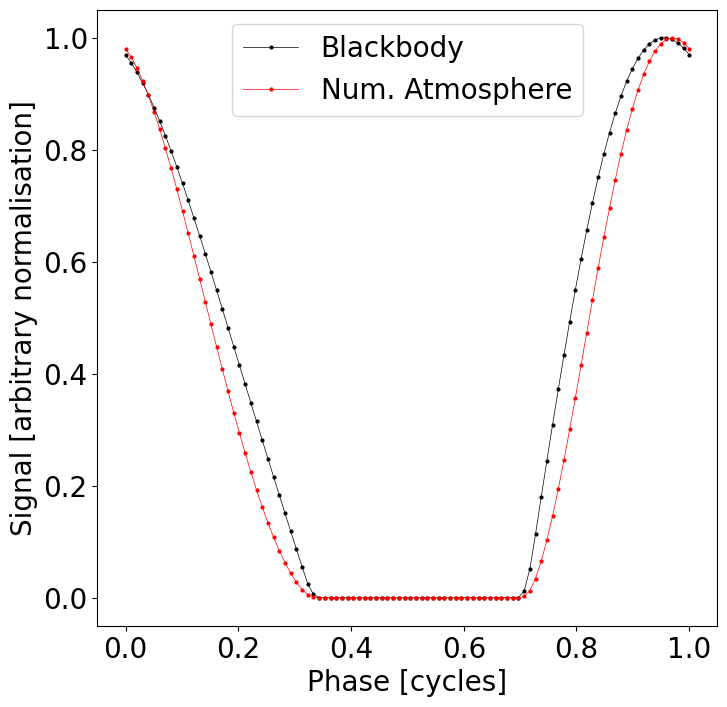
[ ]: